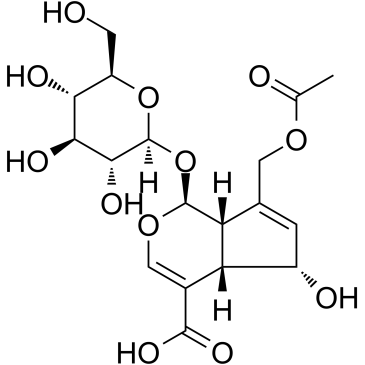Asperulosidic acid
Modify Date: 2024-01-03 19:44:39

Asperulosidic acid structure
|
Common Name | Asperulosidic acid | ||
|---|---|---|---|---|
| CAS Number | 25368-11-0 | Molecular Weight | 432.37600 | |
| Density | 1.64±0.1 g/cm3 | Boiling Point | N/A | |
| Molecular Formula | C18H24O12 | Melting Point | N/A | |
| MSDS | USA | Flash Point | N/A | |
Use of Asperulosidic acidAsperulosidic Acid (ASPA), a bioactive iridoid glycoside, is extracted from the herbs of Hedyotis diffusa Willd. Asperulosidic Acid (ASPA) has anti-tumor, anti-oxidant, and anti-inflammatory activities[1].ASPA is related to the inhibition of inflammatory cytokines (TNF-α, IL-6) and mediators via suppression of the NF-κB and mitogen-activated protein kinase (MAPK) signaling pathways[2]. |
| Name | Asperulosidic acid |
|---|---|
| Synonym | More Synonyms |
| Description | Asperulosidic Acid (ASPA), a bioactive iridoid glycoside, is extracted from the herbs of Hedyotis diffusa Willd. Asperulosidic Acid (ASPA) has anti-tumor, anti-oxidant, and anti-inflammatory activities[1].ASPA is related to the inhibition of inflammatory cytokines (TNF-α, IL-6) and mediators via suppression of the NF-κB and mitogen-activated protein kinase (MAPK) signaling pathways[2]. |
|---|---|
| Related Catalog | |
| In Vitro | Asperulosidic Acid (ASPA) (40-160 μg/mL; pre- 1 hour) significantly down-regulates the mRNA levels of TNF-α and IL-6 in LPS-induced RAW 264.7 cells compared with the group treated with LPS alone [1]. Asperulosidic Acid (ASPA) (40-160 μg/mL; pre- 1 hour) decreases IκB-α phosphorylation in a concentration-dependent manner, decreases Erk1/2 phosphorylation at all concentration levels, but there was no effect on p-p38 [1]. RT-PCR[2] Cell Line: RAW 264.7 cells Concentration: 40 μg/mL, 80 μg/mL, and 160 μg/mL Incubation Time: Pre-treatment 1 hour Result: Decreased TNF-α and IL-6 mRNA expression. Western Blot Analysis[2] Cell Line: RAW 264.7 cells Concentration: 40 μg/mL, 80 μg/mL, and 160 μg/mL Incubation Time: Pre-treatment 1 hour Result: Decreased IκB-α phosphorylation and Erk1/2 phosphorylation. |
| References |
| Density | 1.64±0.1 g/cm3 |
|---|---|
| Molecular Formula | C18H24O12 |
| Molecular Weight | 432.37600 |
| Exact Mass | 432.12700 |
| PSA | 192.44000 |
| Storage condition | 2-8°C |
| Water Solubility | Freely soluble (160 g/L) (25 ºC) |
| RIDADR | NONH for all modes of transport |
|---|
|
Identification of the absorbed components and metabolites of Zhi-Zi-Da-Huang decoction in rat plasma by ultra-high performance liquid chromatography coupled with quadrupole-time-of-flight mass spectrometry.
J. Pharm. Biomed. Anal. 111 , 277-87, (2015) Zhi-Zi-Da-Huang decoction (ZZDHD), consisting of Gardenia jasminoides Ellis, Rheum palmatum L., Citrus aurantium L. and Sojae Semen Praeparatum, is a widely used traditional Chinese medicine preparati... |
| asuperlosidic acid |
| (1S,4aS,5S,7aS)-7-Acetoxymethyl-5-hydroxy-1-((2S,3R,4S,5S,6R)-3,4,5-trihydroxy-6-hydroxymethyl-tetrahydro-pyran-2-yloxy)-1,4a,5,7a-tetrahydro-cyclopenta[c]pyran-4-carboxylic acid |
| Asperulosidinsaeure |

